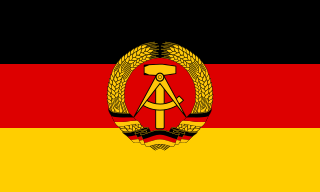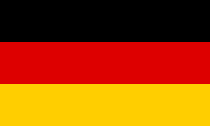
East Germany, officially the German Democratic Republic, was a country in Central Europe that existed from its creation on 7 October 1949 until its dissolution on 3 October 1990. Until 1989, it was generally viewed as a communist state, and it described itself as a socialist "workers' and peasants' state". Before its establishment, the country's territory was administered and occupied by Soviet forces with the autonomy of the native communists following the Berlin Declaration abolishing German sovereignty in World War II; when the Potsdam Agreement established the Soviet-occupied zone, bounded on the east by the Oder–Neisse line. The GDR was dominated by the Socialist Unity Party of Germany (SED), a communist party from 1949 to 1989, before being democratized and liberalized under the impact of the Revolutions of 1989 against the communist states, helping East Germany be united with the West. Unlike West Germany, SED did not see its state as the successor of the German Reich (1871–1945) and abolished the goal of unification in the constitution (1974). Under the SED rule, GDR was often judged as a Soviet satellite state; most scholars and academics described it as a totalitarian regime.

The Basic Law for the Federal Republic of Germany is the constitution of the Federal Republic of Germany.
In 1994 Guatemala's Commission for Historical Clarification - La Comisión para el Esclarecimiento Histórico (CEH) - was created as a response to the thousands of atrocities and human rights violations committed during the decades long civil war that began in 1962 and ended in the late 1990s with United Nations-facilitated peace accords. The commission operated under a two-year mandate, from 1997 to 1999, and employed three commissioners: one Guatemalan man, one male non-national, and one Mayan woman. The mandate of the commission was not to judge but to clarify the past with "objectivity, equity and impartiality."

A truth commission, also known as a truth and reconciliation commission or truth and justice commission, is an official body tasked with discovering and revealing past wrongdoing by a government, in the hope of resolving conflict left over from the past. Truth commissions are, under various names, occasionally set up by states emerging from periods of internal unrest, civil war, or dictatorship marked by human rights abuses. In both their truth-seeking and reconciling functions, truth commissions have political implications: they "constantly make choices when they define such basic objectives as truth, reconciliation, justice, memory, reparation, and recognition, and decide how these objectives should be met and whose needs should be served".
The Equity and Reconciliation Commission is a Moroccan human rights and truth commission created on January 7, 2004, when King Mohammed VI signed a Dahir. The commission was established to reconcile victims of human rights abuses, such as torture, forced disappearances and arbitrary arrests, committed by the government and high-ranking officials during the Years of Lead, with the State. The commission investigates events from 1956 to 1999, spanning the reign of the two previous monarchs. The proclaimed objectives of the commission were the protection and the promotion of the human rights in Morocco.
Transitional justice is a process which responds to massive human rights violations through judicial redress, political reforms in a region or country, and other measures in order to prevent the recurrence of human rights abuse. Transitional justice consists of judicial and non-judicial measures implemented in order to redress legacies of human rights abuses. Such mechanisms "include criminal prosecutions, truth commissions, reparations programs, and various kinds of institutional reforms" as well as memorials, apologies, and various art forms. Transitional justice is instituted at a point of political transition classically from war to positive peace, or more broadly from violence and repression to societal stability and it is informed by a society's desire to rebuild social trust, reestablish what is right from what is wrong, repair a fractured justice system, and build a democratic system of governance. The core value of transitional justice is the very notion of justice—which does not necessarily mean criminal justice. This notion and the political transformation, such as regime change or transition from conflict are thus linked to a more peaceful, certain, and democratic future.

The Commission for Reception, Truth and Reconciliation in East Timor was an independent truth commission established in East Timor in 2001 under the UN Transitional Administration in East Timor (UNTAET) and charged to “inquire into human rights violations committed on all sides, between April 1974 and October 1999, and facilitate community reconciliation with justice for those who committed less serious offenses.” The idea of a truth commission in East Timor was first agreed by the National Council of Timorese Resistance in 2000.

The Federal Foundation for the Reappraisal of the SED Dictatorship is a government-funded organisation established in 1998 by the German parliament.

Aniceto Guterres Lopes is an East Timorese politician and human rights lawyer.

In Brazil, the National Truth Commission investigated human rights violations of the period of 1946–1988 - in particular by the authoritarian military dictatorship that ruled Brazil from April 1, 1964 to March 15, 1985.

The Indonesia–Timor Leste Commission on Truth and Friendship was a truth commission established jointly by the governments of Indonesia and East Timor in August 2005. The commission was officially created to investigate acts of violence that occurred around the independence referendum held in East Timor in 1999 and sought to find the "conclusive truth" behind the events. After holding private hearings and document reviews, the commission handed in the final report on July 15, 2008 to the presidents of both nations, and was fully endorsed by Indonesian President Susilo Bambang Yudhoyono, providing the first acknowledgement by the government of Indonesia of the human rights violations committed by state institutions in Timor. The commission is notable for being the first modern truth commission to be bilateral.
The Haitian National Truth and Justice Commission began its operations in April 1995 and ended in February 1996. Haiti's once diverse and lively civil society had been tarnished greatly as a result of the ousting of its first democratically elected president, Jean-Bertrand Aristide, by its military forces. This deposing of President Aristide is widely known as a coup d'état, and from 1991 to 1994, the country became known for its weak civilian government. The army was determined to return Haiti to the intimidated society existing during the Duvalier dictatorship seven years prior.

Zersetzung was a psychological warfare technique used by the Ministry for State Security (Stasi) to repress political opponents in East Germany during the 1970s and 1980s. Zersetzung served to combat alleged and actual dissidents through covert means, using secret methods of abusive control and psychological manipulation to prevent anti-government activities. People were commonly targeted on a pre-emptive and preventative basis, to limit or stop politically incorrect activities that they may have gone on to perform, and not on the basis of crimes they had actually committed. Zersetzung methods were designed to break down, undermine, and paralyze people behind "a facade of social normality" in a form of "silent repression".
The Commission of Inquiry to Locate the Persons Disappeared during the Panchayat Period (1990–1991) is a truth commission established in Nepal in 1990 after the end of the autocratic Panchayat Regime by the first post-Panchayat Prime Minister Krishna Prasad Bhattharai. The commission was set up to examine allegations of human rights violations and inquire about enforced disappearances during the Panchayat system from 1961 to 1990. A report was officially submitted to the government in 1991, but it was made public only in 1994. The commission identified 35 persons disappeared on about one hundred studied cases. However, no alleged perpetrators were judged.
The Sierra Leone's Truth and Reconciliation Commission was a truth commission created as part of the Lomé Peace Accord, which ended the 11-year civil war conflict in Sierra Leone in July 1999.
The Commission of Inquiry into the Crimes and Misappropriations Committed by Ex-President Habré, His Accomplices and/or Accessories was established on December 29, 1990, by the President of Chad, Idriss Déby. Its goal was to investigate the "illegal detentions, assassinations, disappearances, torture, mistreatment, other attacks on the physical and mental integrity of persons; plus all violations of human rights, illicit narcotics trafficking and embezzlement of state funds between 1982 and 1990", when former President Hissène Habré was in power.
Peru's Truth and Reconciliation Commission was a truth and reconciliation commission established by President Alejandro Toledo to investigate the human rights abuses committed during the internal conflict in Peru between 1980s and 1990s. The TRC was a response to the violent internal conflict between 1980 and 2000 during the administration of Presidents Fernando Belaúnde (1980–1985), Alan García (1985–1990), and Alberto Fujimori (1990–2000). The commission's mandate was to provide a record of human rights and international humanitarian law violations committed in Peru between May 1980 and November 2000, as well as recommend mechanisms to promote and strengthen human rights. The TRC reported on the estimated 70 000 deaths, assassinations, torture, disappearances, displacement, employment of terrorist methods and other human rights violations executed by the State, Shining Path, and the Túpac Amaru Revolutionary Movement. The report concluded that there is both institutional and individual accountability, as well as identifying racial and cultural factors that became a catalyst for conflict.
The Human Rights Violations Investigation Commission of Nigeria, also known as the Oputa Panel after its leader Chukwudifu Oputa, was a commission that was developed following the collapse of the military dictatorship that controlled Nigeria until 1998. It was created by Olusegun Obasanjo, the newly elected President of Nigeria, in 1999. Its mandate was to investigate human rights during the period of military rule from 1984 to 1999. In terms of reconciliation, the commission also worked towards unifying communities previously in conflict. The commission submitted its final report to President Obasanjo in 2002, but the government has not taken any action to date. Its report was not released to the public until 2005, when it was published by two activist groups, the Nigerian Democratic Movement and Nigeria-based Civil Society Forum.

Right to truth is the right, in the case of grave violations of human rights, for the victims and their families or societies to have access to the truth of what happened. The right to truth is closely related to, but distinct from, the state obligation to investigate and prosecute serious state violations of human rights. Right to truth is a form of victims' rights; it is especially relevant to transitional justice in dealing with past abuses of human rights. In 2006, Yasmin Naqvi concluded that the right to truth "stands somewhere on the threshold of a legal norm and a narrative device ... somewhere above a good argument and somewhere below a clear legal rule".











